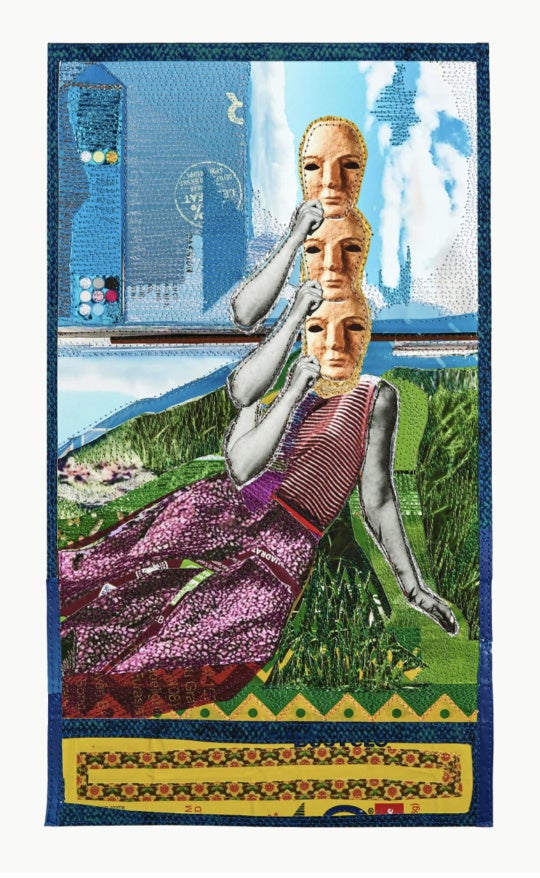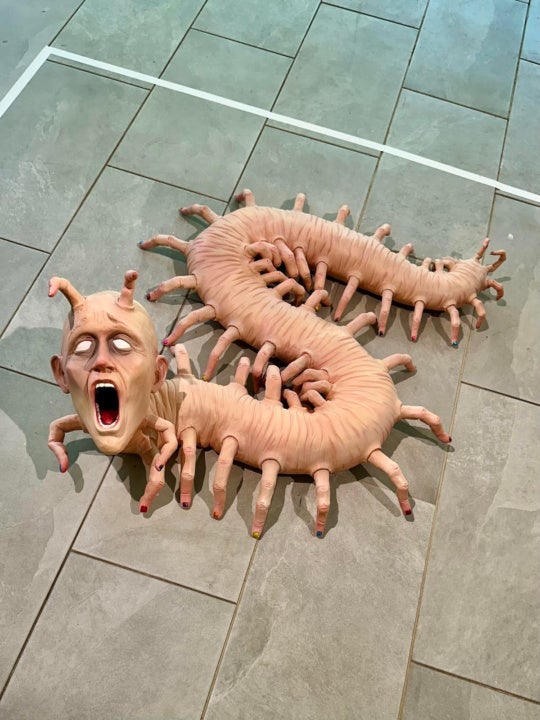
In her 1987 essay “Sex and Death in the Rational World of Defense Intellectuals,” a critique of the euphemistic language used by professionals in the arms industry, feminist scholar Carol Cohn writes, “Anyone who has seen pictures of Hiroshima victims or tried to imagine the pain of hundreds of glass shards blasted into flesh may find it perverse beyond imagination to hear a class of nuclear devices matter-of-factly referred to as ‘clean bombs’… This language has enormous destructive power, but without the emotional fallout that would result if it were clear one was talking about plans for mass murder, mangled bodies, and unspeakable human suffering.”
Cohn’s essay investigates the ways in which arms professionals’ jargon distances their discourse from physical violence, but it also documents sexualized and gendered metaphors within these euphemistic phrases. One of the large-scale wall drawings in Sarah Emerson’s exhibition “Are We the Monsters”—on view at Kennesaw State University’s Zuckerman Museum of Art through July 1—appears to be the Atlanta artist’s response to the gendered phrase the “mother of all bombs,” which was used to describe a large-yield explosive deployed for the first time by the US military in Afghanistan last spring.
At that time, the “mother of all bombs” (or, officially speaking, the GBU-43/B Massive Ordinance Air Blast) was the strongest non-nuclear weapon in the American military’s arsenal, and its inaugural operational use killed nearly 100 people, including at least two civilians. In Emerson’s wall drawing Mother of All, the first word of the title phrase appears in large tilting letters atop cartoonish smoke clouds rendered in a limited black-and-white palette reminiscent of newsprint. Five pairs of disembodied eyes float Cheshire Cat-like amid the rising smoke, and thick lines of black paint descend from the M in Mother, evoking dripping blood.
More broadly than critiquing one euphemistic phrase, “Are We the Monsters” shows Emerson unfurling and detailing a fantastical panoramic landscape of fear and carnage. Her approach to portraying this violence avoids realism in favor of exaggeration and dark whimsy. Even while joining in a long tradition of artists decrying the atrocities of war, she resists pursuing the sort of shock elicited from viewers by those such as Martha Rosler, who inserted photographic images of atrocities in Vietnam originally printed in Life into lavish interior spreads from House Beautiful for her 1967-1972 collage series House Beautiful: Bringing the War Home. Emerson instead draws the viewer into a flattened dystopian world that owes a greater debt to newspaper comic strips and Alice in Wonderland than it does to photojournalism.

Emerson’s embrace of comic strip aesthetics is most unabashedly displayed in a smaller gallery adjoining the main one featuring her large wall drawings. Here, on a wall painted with broad black and white vertical stripes, thirteen works on paper are hung salon-style in a way that evokes the graphic organization of a comic book page. (You can almost imagine it as a corner of the bedroom of Wednesday Addams or Winona Ryder’s Lydia from Beetlejuice.) Some of these black and white works largely resemble variations on the wall drawings in the adjoining gallery, but other delicately rendered watercolor and gouache works called No More Dreaming Like a Girl 1, 2, and 3 depict images suggesting twisted myths and fables: a naked woman who appears to crawl against a pink background and a wolf approaching a deer carcass. (Emerson previously called a mural at Atlanta Contemporary No More Dreaming Like a Girl in 2012.) In another watercolor, the artist continues to riff on the American graffiti meme “Kilroy was here,” which has appeared previously in her signature wraparound wall drawings. In this work, however, the words are scrawled on a headstone.
Though she borrows visual language from fairy tales and animated antics, Emerson’s work contains darker undertones related to environmental anxieties, fractured landscapes, fantasy, and desire. In “Are We the Monsters,” these subconscious fears have been revealed like a scab-peeled psychological wound, which is less due to Emerson’s individual experience and more to apocalyptic feelings that have swept across the US and the world in the wake of Donald Trump’s election as president. In one graphically striking drawing, the words “WE’RE ALL GONNA” and a line drawing of a burning campfire are the only elements not engulfed by black ink. Another drawing places Trump’s words “fire and fury,” one of his comments regarding potential nuclear conflict with North Korea, within a dark plume of smoke dotted with pairs of open eyes.
Glowing under black lights in a darkened gallery, Emerson’s large-scale painting Berserk Planet infuses these nuclear anxieties into a landscape of flames, skulls, and smoke, unfurling across the wall like a neon, superflat update of Bosch’s Garden of Earthly Delights. More than any other work in “Are We the Monsters,” Berserk Planet resembles the wraparound painting installation from Emerson’s 2015 Working Artist Project exhibition “The Unbearable Flatness of Being” at MOCA GA. Lit by black lights, however, the psychedelic destruction in Berserk Planet appears unbound from the limits of canvas. Floating like a hallucination in front of the viewer, the varied components of its image seem to encroach and recede at the same time.

Black lights and glow-in-the-dark paint aside, Berserk Planet and Emerson’s earlier painting The Unbearable Flatness of Being share several visual elements: wide cartoon eyes, candy-colored psychedelia, smoke and skulls. Within the context of “Are We the Monsters”—and, let’s be real, 2018—a painting like this called Berserk Planet feels eminently political and commendably daring, somehow suggesting contemporary life is both a post-apocalyptic horror film and a cartoon. But a broader appraisal of Emerson’s work shows that these dire undertones have long been present, lurking surreptitiously beneath logs borrowed from Disney woodlands.
The lack of wider perception of these political concerns is no fault of the artist, whose work is slyer and smarter that some viewers may give her credit for, especially if they haven’t yet seen this exhibition. Aside from her large-scale wall paintings, Emerson is also well known for painting the exterior of the recently shuttered Mammal Gallery downtown and as a participant in the street art festival Living Walls. Such projects have a made her a perennial and widespread local favorite. As welcome as her delightful murals may be, the broad understanding of Emerson’s work should not be reduced to facile or saccharine interpretations gleaned only from glancing looks. “Are We the Monsters” shows the Zuckerman Museum of Art, nestled in Atlanta’s northern suburbs, doing precisely what many people say more museums in the city should: giving an Atlanta-based artist’s work the serious attention and institutional visibility its complexity warrants.
“Are We the Monsters” is on view at the Zuckerman Museum of Art on the campus of Kennesaw State University through July 1.
Logan Lockner is an Atlanta-based critic and a contributing editor for BURNAWAY. His first curatorial project, Lauren Sanders: Interiors and Props, opens on May 10 at Georgia State University’s Welch Galleries.




